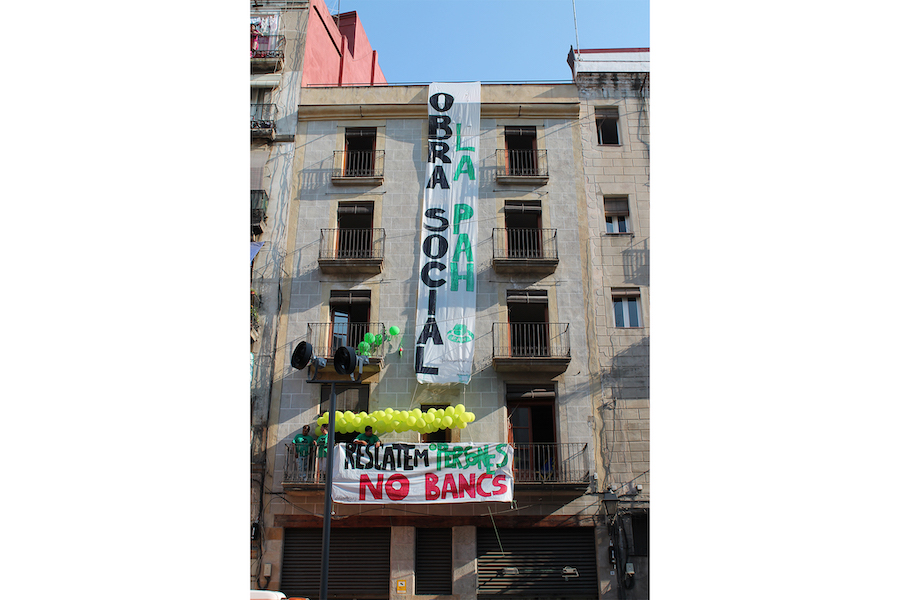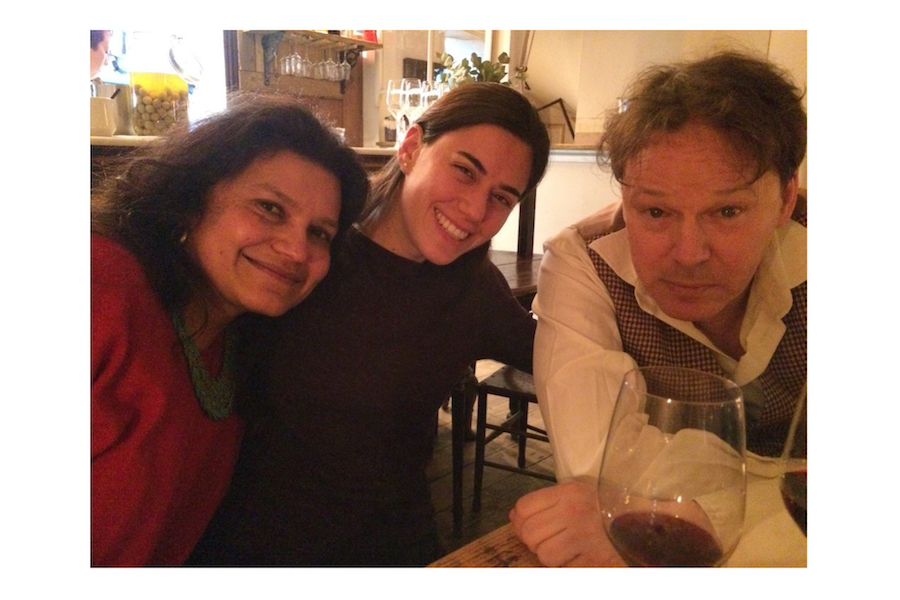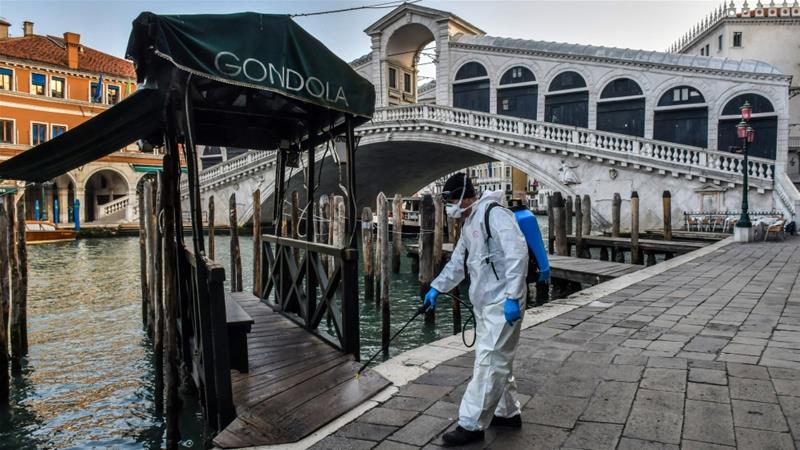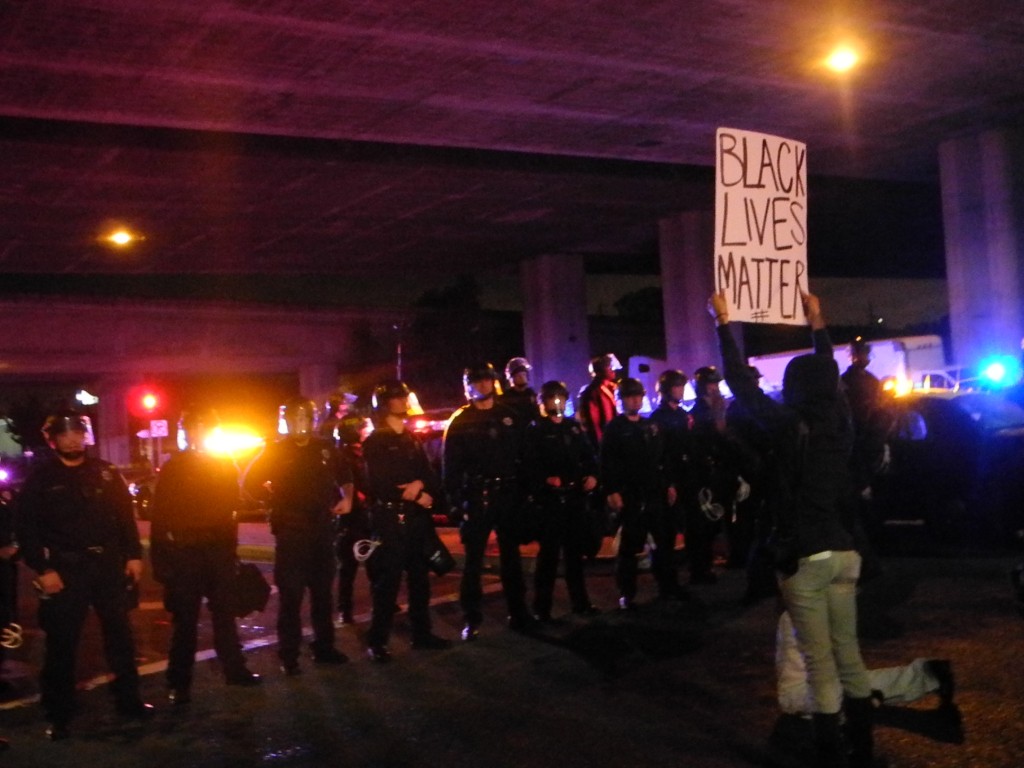On June 19, 2022, the united left party, NUPES (New Ecological and Social Popular Union), cobbled together by Jean-Luc Melenchon in less than two months, won enough seats to become the official opposition in the French National Assembly. How should we understand the growth of this left alliance in France which seems to have taken political pundits by surprise?
Since 2015, I have been conducting ethnographic research on progressive social transformation in Paris and, in fact, documenting the emergence of the counter-hegemonic bloc represented in this alliance. I have focused on what has been called “commoning” (Nonini 2007; Stavrides 2015; Susser 2016, 2017, 2018; Dardot and Laval 2019), the process of creating commons, to consider the ways in which this form of popular contestation is transforming political subjects, generating collective ethics, and reconfiguring democracy.

Two aspects of commoning help to illuminate the current elections. The first is the creation of a new political subject and a political vision through a process of sharing and community activities. The second is the process of thresholding or crossing of transitional space that led to alliances among groups who had not previously recognized common interests. I argue that both aspects contributed to the creation of a public oriented in the direction of social justice, inclusivity and a collaborative left leaning political bloc.
To illustrate these processes, I focus on the Gilets Jaunes, a movement which emerged in November 2018. From the start there was much debate in France and internationally about whether to characterize the Gilets Jaunes as right or left in the context of Brexit, Trump, and most significantly, Marine Le Pen, head of the extreme right party in France (Rogozinski 2019, Balibar 2019 and many others). It is this dilemma that made these protests particularly important from an analytic and practical political perspective.
Historical Conjuncture and Crisis
In 2016, the Socialist government of Francois Hollande, with Emmanuel Macron as economy minister, initiated legislation to change the labor laws. Although policies to reduce public spending and increase the flexibility of employment had been gradually implemented for some time, this major effort by a Socialist government to change the labor laws set off a political crisis.
Because of this crisis, a new era of street protest emerged in Paris. The first of the protests was Nuit Debout, which began on March 31, 2016. This movement echoed the historic squares occupations of Southern Europe in 2011, although it took place five years later. As previously, in Spain, the call to action was initially to join the unions in support of the traditional labor laws that a socialist government proposed to relax.
The attempt to change the labor laws, and the protests in response, dramatically undermined the legitimacy of the Socialist Party. The political conjuncture of this event with allegations of fraud on the traditional right opened the way for a new political configuration in France. In this vacuum, the newly created party led by Macron, the left party created by Jean-Luc Melenchon in 2012, and the marginal far right, reincarnated by Marine Le Pen, re-oriented the national arena.
Taking advantage of the wide-open field, in May 2017, Macron, without a traditional party but strongly supported by corporate funding, was elected President for the first time. He rapidly began to implement far-reaching changes. In the interests of workforce flexibility, he weakened employment security and later tried to alter the calculation of union pensions as well as increase the age for pension entitlements. Student admissions to public universities were re-organized and health workers and teachers faced layoffs. The threat of worker disciplining in the interests of capital became widely feared. Each change was accompanied by massive social movements and street uprisings.
Over the years of the first Macron presidency, many different groups under different kinds of pressures opposed the new changes. Resistance took the form of both organized strikes and wildcat worker strikes, the occupation of squares, student sit ins and street rebellions. In November 2018, the Gilets Jaunes uprising began. Finally in 2019, a mass movement was organized by unions to oppose the dismantling of the national pension plans. I analyze the Gilets Jaunes within this broader historical arena as well as in contrast or comparison with the protest movements I have been observing in the United States.
The Gilets Jaunes and Commoning
The Gilets Jaunes began as a one issue protest, against the gas tax. The message was spread through Facebook, and other platforms. Still organizing around one issue, the protesters began to meet in real time, at roundabouts, crossroads and along highways in many parts of France. Next, Gilets Jaunes took to the streets of Paris in enormous and unprecedented marches on successive Saturdays for over eighteen months.
As people who lived near one another but had not necessarily met before began to meet regularly, they began to build a shared sense of community. Starting out as a mixture of pensioners, and many poor and disabled people from the provinces, including disengaged socialists and Le Pen supporters, the Gilets Jaunes can be seen as negotiating positions over time. Negotiations took place within the space of the commoning experience during the occupations, the general assemblies, the assemblies of assemblies and the massive Saturday demonstrations.
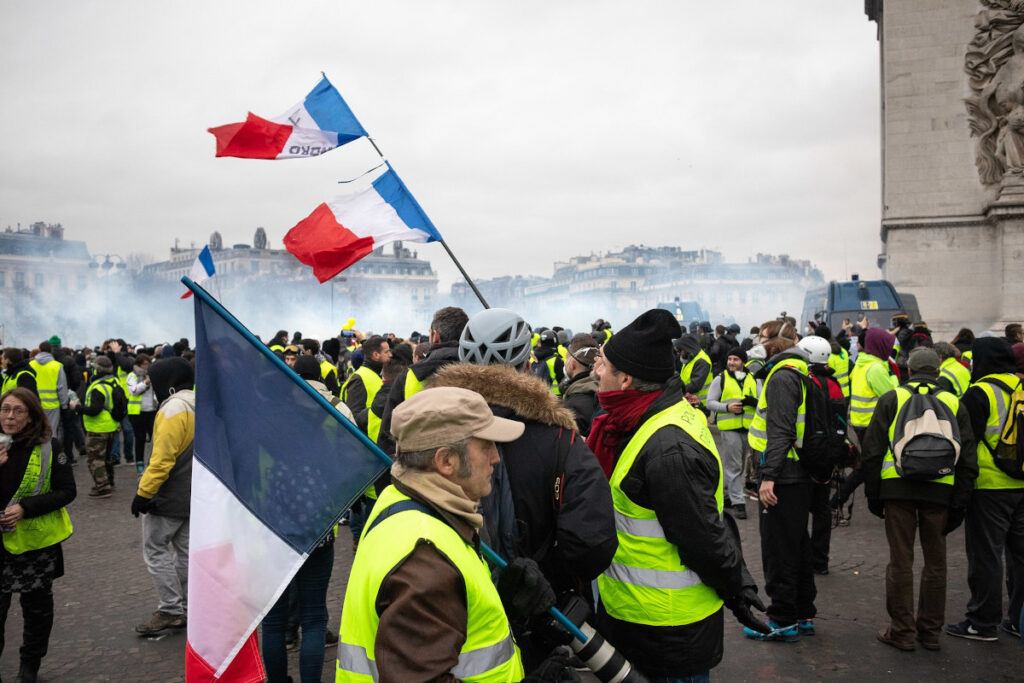
The community was built in multiple ways: by barbecues and picnics, by bringing children to play in the environment, by building cabins, sometimes making them comfortable for wintry stays. Saturday afternoons were spent grouping close together in the cold to keep warm in wind, rain and snow, and some Saturday evenings around fires and in cabins. Gilets Jaunes wrote personal statements and commentaries on the backs of their vests. They spray painted slogans and arrayed tags, posters, and banners as well as other forms of graffiti (Le Comité de soutien 31 2019) along the routes of the demonstrations. The yellow vests and the songs such as the ever-present “On est la” generated a sense of belonging and became a signal that Gilets Jaunes were present in whatever guise they happened to be. Over time, singing the song simply indicated that people emulated and echoed the Gilets Jaunes in other demonstrations. Experiences such as this can be seen as the commoning process of the Gilet Jaunes.
Through meeting several times, a week, sharing narratives, singing Gilets Jaunes songs and, dressing in the familiar yellow vests, group members built a, possibly fragile, sense of solidarity in ways that crisscrossed over divisions of family, income, color, and age, and maintained a strong belief that the disabled were part of the community. Negotiations involved a recognition that poverty and distress need not be shameful but were a product of changing circumstances and uncaring or destructive government policies. As a result, in difficult, often physically uncomfortable, conditions, principles of cooperation were established along with a belief in horizontalism and an aversion to political leaders.
Où sont les neiges d’antan? (Where are the snows of yesteryear?)
Analysts have discussed the solidarity of factory floors or assembly lines and even nostalgia with respect to that solidarity (Muehlenbach 2017). Following Lefebvre there has also been a recognition of the solidarity of the streets and public spaces (Lefebvre 1971, Harvey 2012, Susser and Tonnelat 2013). The experience of the Gilets Jaunes points to the creation of a critical public at the roundabouts which generated or echoed the affect of the lost village community.
Such nostalgia has historically generated conservatism as well as revolutionary ideas (Susser 2008, Williams 1983). The question became, in what ways would this community be invested with emotions? It could generate an exclusive nationalism (as today in Hungary, Romania, or Poland) or a wider sharing sense of the needs of the poor and disabled.
In an ever-evolving process, people came to the roundabouts and talked among one another of their economic challenges and domestic hardship. They managed to escape the individual humiliations of poverty and household desperation, of their unrelenting work for not enough pay, their exhaustion and lack of belief in their own or their children’s future. Instead, they talked collectively about the degradation of everyday life – the loss of a village center, a post office, a bakery, and a public square; the loss of local schools; the need to drive long distances for employment and childcare; and the endless drudgery of work which did not allow sufficient time or provide the means to help their children, their elderly or disabled neighbors and relatives or meet their friends (Susser 2020). Their nostalgia recalled the loss of a social existence centered around local services and a secure welfare state and became the basis of their rage against Macron’s neoliberal policies.
Thresholding
The second aspect of commoning which contributed to a progressive or left positioning on the spectrum was what has been called thresholding (Stavrides 2015). Analysts (Stavrides 2015) have talked of “thresholds” to distinguish commoning from more right wing or nationalist movements claiming territory. The idea was that open doors or thresholds connected different groups which allowed for inclusivity while at the same time recognizing ethnic and other identities upon which the different groups were based. If commoning creates groups which are built on experiences of sharing in new ways, thresholds are a basis for sharing across groups. Thresholding be understood in much the same way as rites of passage which Arnold Van Gennep (1960) saw as taking place in three stages, separation, transition, and incorporation (see also Turner 1958).
We might consider moments of liminality, such as occupations, freezing afternoons at roundabouts or possibly the common experience of violence in the streets as the moments of separation and transition. These represent challenging and bonding processes taking place in liminal or temporarily undefined space. In sharing such trying circumstances, people cross thresholds of trust and build bridges across unusual groups, in processes of incorporation. Thus, what might be understood as prefigurative politics which emerged in the practice of street protests included both commoning and the recognition of many autonomous groups working together: In other words, inclusivity, and thresholds to new populations.
Environment, convergence, and thresholding
Thresholding among the Gilets Jaunes occurred with respect to the environmental movement. Emmanuel Macron had announced the gas tax as an effort to curb the use of this gas for environmental reasons. Consequently, the Gilets Jaunes protest against the gas tax was interpreted by the government and the media as a protest against ecology. Over the next two years, much time and effort were put into convergence. Environmentalists who were also Gilets Jaunes and others who organized joint marches, teach ins and conferences worked to counteract stereotypes and to build thresholds between the two movements.
In February 2019, the environmental movement staged a demonstration on a Saturday afternoon in Paris which the Gilets Jaunes joined. They started together. However, after the first few blocks the Gilets Jaunes parted ways from the permitted route of the ecological demonstration and made their way on a “wild” protest (undeclared) towards the Champs Élysées. Later all the groups met again listening to passionate speeches at La Place de la République. Some youthful Gilets Jaunes were sitting in the square wearing flowers in their hair reminiscent of green protests over many decades. After about 6pm, as dusk settled, violence suddenly erupted, traffic was stopped, and the square was closed off by police. From the point of view of the Gilets Jaunes, the violence was in response to police arrests in the square.
In spite, or possibly because, of the evening clashes, this demonstration clearly opened portals between the Gilets Jaunes and the environmentalists. From early 2019, “The end of the month and the end of the world” became a characteristic slogan of the Gilets Jaunes. Climate activists continued their efforts towards convergence. The Gilets Jaunes never became a climate movement, but the polarization claimed by the government was not supported by later events. Rites of passage in shared marches and other experiences had opened thresholds for collaboration.
Police brutality and thresholds of race
As I described in a previous post in FocaalBlog (Susser 2020), the #BlackLivesMatter protests in the US were followed by massive demonstrations against police brutality in France. Although police brutality was a long-time theme of the Gilets Jaunes, this time the Paris protests, while including the Gilets Jaunes, focused specifically on the brutality against youth and people of color. This recognition of common problems represented newly possible thresholding between the Gilets Jaunes and people of color from the banlieues.
Here, thresholds were opened between so-called but no longer stable working classes, the imagined middle classes also at risk of instability, and the super-exploited subjects divided by racism, sexism, colonialism, citizenship, and other forms of historical subordinations.
Joint marches between Gilets Jaunes and people of color most subject to police brutality were not an ongoing phenomenon but again this demonstrated the opening of a portal for common understandings.
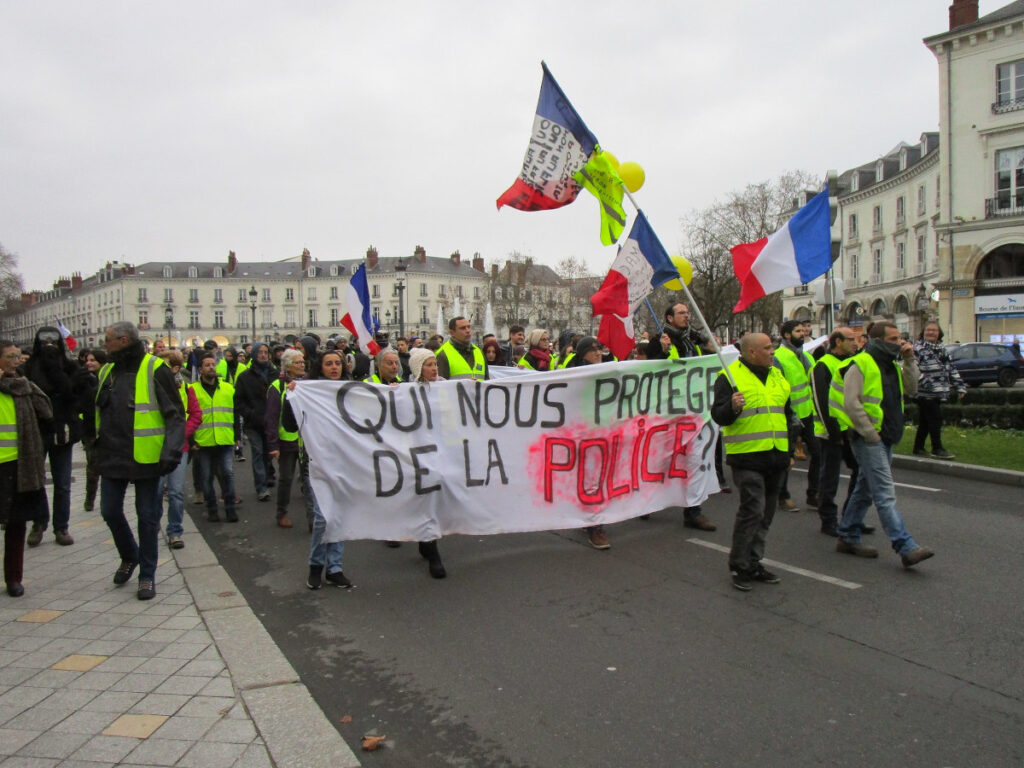
Unions and strikes: thresholding on the left
Many Gilets Jaunes were suspicious of unions and many unions refused to officially march with Gilets Jaunes. However, despite this contentious relationship, there were collaborative efforts on May Day marches and elsewhere. Gilets Jaunes picketed many early mornings with bus drivers when they were out on strike. After the strike, the bus drivers organized a barbecue in front of a bus headquarters for Gilets Jaunes who had come out on those cold winter mornings: one of many thresholding events among strikers and Gilets Jaunes.
The silence of others: a more controversial example of thresholding
While there was openness among the Gilets Jaunes about not having enough to live on and many domestic challenges, Gilets Jaunes avoided talking about the politics of left and right. Their reticence over political persuasions was not surprising in the polarized political situation of France. In 2017, Macron had successfully used the fear of fascism and the history of the Vichy government to mobilize voters in opposition to Marine Le Pen in the second-round elections.
In 2018, as hundreds of thousands of Gilets Jaunes poured into Paris from the provinces, both Le Pen, on the extreme right, and Jean-Luc Melenchon, on the left, pledged support. Reporters and participants claimed that in ACTE 3, Le Pen nationalists led the assault on the Arc de Triomphe. The international leftist Black Bloc may have led the attack on the elite restaurant Le Fouquet a few months later. The participation of many on the left in the protests, and the roundabouts over time led to a movement that called for a diverse democratic voice and the extreme right became marginalized.
While the Gilets Jaunes expressed their rage in breaking windows and other property and participated in attacks on the Arc de Triomphe and Le Fouquet, they did not accept political leadership from either the far right or the left. Silence with respect to political affiliation and the rejection of an official leadership remained a determined response.
Although disagreeing in fundamental ways, Gilets Jaunes were more or less uniform in their hatred of Macron. They believed that he was “stealing the state” with his privatization policies and cutbacks in funding for services and public employment. They blamed the government for the destruction of a middle-class lifestyle either for themselves or for their children.
Collaboration for a political bloc was not based on a romantic image of common identity. Rather it was built on a restrained acceptance of political difference in a common rage about the loss of accustomed living conditions. This contrasts sharply with the US where polarization between left and right has become more extreme.
Trump, class, and thresholds in the United States
Although the presidential campaign of Bernie Sanders certainly raised the possibility (Susser 2018), no political bloc has yet emerged to work across the vicious polarization in the United States. Trump demonstrators also come from the shrinking middle class and displaced affluent working class partially represented in the Gilets Jaunes. However, they have moved to the right and responded to the Trumpian rhetoric of anti-immigrants, whispered racism, antisemitism and now even the adoption of theories of the Great Replacement. What can explain these different reactions to some similar circumstances?
Analysts have been concerned that Gilets Jaunes, like Trump supporters, were opening an avenue for the antisemitism, racism, and anti-immigrant rhetoric expressed by the growing far right. Indeed, in recognition of the popularity of Le Pen, Macron adopted some rightwing exclusive rhetoric. A popular surge to the right was a frightening possibility. However, the Gilets Jaunes did not evolve into a movement fundamentally based on hatred of the other. Instead, as a movement they focused their desperation and rage against Macron’s shredding of the welfare state and reduction in investment in areas outside gentrified Paris (Hazard 2020). They demanded a more receptive democracy and not an authoritarian state.
Conclusions
As political pundits have finally noticed, a new political bloc or a working class with consciousness or agency is emerging. Commoning and the generation of shared values as well as thresholding across autonomous groups were particularly significant in the long-term building of this oppositional left bloc. An important part of this thresholding was the ability to by-pass the polarization of the extreme right and the extreme left. This unusual collaboration, rarely the product of any explicit negotiations, allowed the extraordinary and inspirational mass movement of the Gilets Jaunes to avoid the exclusive and racist nationalism evident in the US.
In the presidential elections of 2022, Le Pen, as in 2017, made it through to the second round. However, Melenchon came in a close third. Macron, lacking the broad support evident in 2017, relied on the anti-fascism of the left to pull him through the second round. The power of the left to support Macron against Le Pen was finally negotiated into NUPES, a united left front for the deputy elections for the National Assembly in June 2022.
In the June elections, NUPES won enough seats to become an official opposition and deny Macron his majority in the National Assembly. Some of Macron’s nominated ministers did not even make it into the Assembly. Macron was no longer able to pass the much-hated changes in pensions or his other policies. Marine Le Pen also won more seats than previously. Nevertheless, the success of NUPES clearly represents an unheard-of situation in the fifth French Republic where the President is generally rubber stamped by a weak National Assembly. This new powerful counter-hegemonic political bloc should come as no surprise. It has been formed over five years of extraordinary protest including the collaborative politics of commoning, thresholding and silence in the Gilets Jaunes collective efforts. The forthcoming regime will have to take these progressive voices into account.
Ida Susser is Distinguished Professor of Anthropology at Hunter College and the Graduate Center, City University of New York. Her most recent book is The Tumultuous Politics of Scale, co-edited with Don Nonini.
References
Balibar, Etienne. 2019. Le sens du face-à-face. In Joseph Confavreux (ed.). Le Fond de l’Air Est Jaune. Editions Seuil
Dardot, Pierre and Christian Laval. 2019. Common: On Revolution in the 21st Century. Bloomsbury Publishing.
Hazard, Benoit. 2020. Lorsque les ‘sans-parts’ se rallient au ‘pouvoir vivre’. Ethnographie des associations des gilets jaunes sur les ronds-points de l’Oise. Condition Humaine/ Condition Politique 1 https://revues.mshparisnord.fr/chcp/index.php?id=237#text
Lefebvre, Henri 2003. The Urban Revolution. University of Minnesota Press.
Muehlebach, Andrea. 2017. The Body of Solidarity. Heritage, Memory, and Materiality in Post-Industrial Italy. Comparative Studies of Society and History 59(1), 96-126.
Comité de soutien 31. 2019. La rue etait noire de jaunes – 500 slogans, tags, affiches, pancartes, dessins, photos, banderoles…. Éditions du croquant.
Nonini, Donald M. (ed.) 2007. The Global Idea of ‘The Commons’. Berghahn
Books.
Rogozinski, Jacob. 2019. Démocratie Sauvage. Lignes 59, 23-36.
Stavrides, Stavros. 2015. Common Space as Threshold Space: Urban Commoning in Struggles to Re-Appropriate Public Space. Footprint 9(1), 9–19.
Susser, Ida. 2016. Considering the urban commons: Anthropological approaches to social movements. Dialectical Anthropology 40(3), 183–198.
Susser, Ida. 2017. Commoning in New York City, Barcelona, and Paris: Notes and Observations from the Field. Focaal 79, 6-22.
Susser, Ida. 2018 Re-envisioning Social Movements in the Global City: from Fordism to the neoliberal era. In Don Kalb and Mao Mollona (eds.). Worldwide Urban Mobilizations. Class struggles and Urban Commoning. Berghahn Books.
Susser, Ida. 2020. Covid, police brutality and race: are ongoing French mobilizations breaking through the class boundaries? FocaalBlog, December 3, https://www.focaalblog.com/2020/12/03/ida-susser-covid-police-brutality-and-race-are-ongoing-french-mobilizations-breaking-through-the-class-boundaries/
Susser, Ida. 2021. “They are Stealing the State”. Commoning and the Gilets Jaunes in France. In Moritz Ege and Johannes Moser (eds.). Urban Ethics. Conflicts Over the Good and Proper Life in Cities. Routledge.
Susser Ida, and Stéphane Tonnelat. 2013. Transformative cities: The three urbans
commons. Focaal 66,105-121.
Turner, Victor. 1958. Schism and Continuity. Manchester University Press.
Van Gennep, Arnold. 1960. The Rites of Passage.University of Chicago Press.
Williams, Raymond. 1983. Culture and Society, 1780–1950. Columbia University
Press.
Cite as: Susser, Ida. 2022. “Melenchon: the creation of a left political bloc.” Focaalblog, 21 June. https://www.focaalblog.com/2022/06/21/ida-susser-melenchon-the-creation-of-a-left-political-bloc/
